
















 |
|
 |                |
Information identified as archived is provided for reference, research or recordkeeping purposes. It is not subject to the Government of Canada Web Standards and has not been altered or updated since it was archived. Please "contact us" to request a format other than those available.
| Canada's Balance of International Payments System of National Accounts Fourth Quarter 2006 Analysis — Fourth quarter 2006 Canada's current account surplus with the rest of the world stood at $3.0 billion in the fourth quarter, on a seasonally adjusted basis, down $2.8 billion from the previous quarter. This was the lowest surplus in more than three years, as a large increase in the deficit on investment income more than offset an improved performance for goods. For the year 2006, the current account surplus fell, due to a lower goods surplus, to $24.3 billion, down $7.5 billion from the 2005 record. 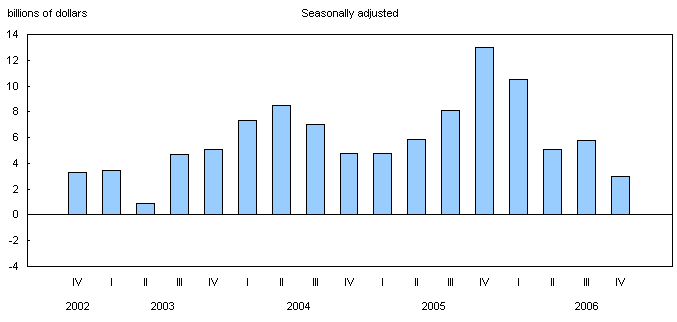 In the capital and financial account (not seasonally adjusted), sizeable investment by foreign direct investors for a second straight quarter was again the result of the acquisitions. On the asset side of Canada's international balance sheet, Canadian portfolio investment abroad was again robust, continuing the strong pace seen in all four quarters, and leading to record purchases of foreign securities in 2006.
Larger deficit on direct investment income In the fourth quarter, the deficit on investment income increased $3.8 billion to $5.7 billion, following one of the lowest deficits in 30 years in the third quarter. Profits on foreign direct investment in Canada reached a record of $8.6 billion. Meanwhile, Canadian investors earned $6.3 billion on their direct investment abroad, a $1.9 billion decline compared to the record high registered during the previous quarter.  For 2006, the $13.0 billion deficit on investment income was the lowest in almost 25 years. Profits on Canadian direct investment abroad reached $29.1 billion, more than double the values recorded in 2003. Over the three-year period, profits from investments in the finance and insurance sector abroad increased by $9.1 billion. In 2006, profits earned on foreign direct investment in Canada remained stable although dividends distributed were the highest ever. Payments of interest on Canadian bonds continued their descent that started at the end of 2002, while interest received on foreign bonds increased by more than $1 billion for the second year in a row. 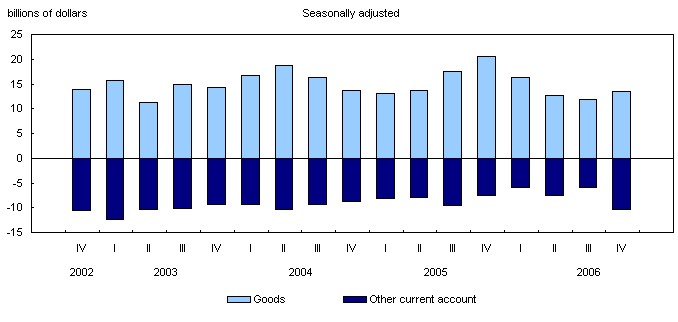 Goods surplus up for the first time in 2006 Following declines for three consecutive quarters totalling $8.7 billion, the goods surplus increased $1.7 billion in the fourth quarter. While imports remained stable, exports went up, in spite of lower energy product exports. Exports of goods went up $1.5 billion in the fourth quarter. Automotive products improved by $1.8 billion after decreasing for three straight quarters. Export values of these products have trended down since their peak at the beginning of 2000. Industrial goods exports increased $1.0 billion, largely due to higher prices, with the exception of the $0.4 billion increase for metal ores which came from a combination of higher volume and price. Exports of energy products recorded a $2.0 billion drop in value after three relatively stable quarters. Large drops for natural gas and petroleum and coal products were due to declines in both volumes and prices, while all the reduction for crude petroleum came from lower prices. For these three product groups, export values on a monthly basis registered their lowest levels in October and increased in each of the following two months. Turning to imports, higher imports of machinery and equipment products and, to a lesser extent, consumer goods and industrial goods, offset a large decrease for crude petroleum. A large part of the reduction in the values of crude petroleum imports came from lower prices. For the year, the goods surplus dropped $10.6 billion to $54.3 billion. Imports increased $16.1 billion, spread across most major groups of products. Industrial goods, led by metals and metals ores, and machinery and equipment, despite lower prices, were the main contributors to the increase. The values of goods exported rose $5.5 billion in 2006. Industrial goods were up $10.1 billion, largely due to higher prices. Metal and alloys counted for two-thirds of the rise. Automotive products lost $5.3 billion, spread between automobiles, trucks and parts. Energy products remained unchanged as the large increase in crude petroleum was offset by an equivalent drop for natural gas. While average prices of crude petroleum rose around 10% in 2006, natural gas prices went down 20%. Services deficit increases again In the fourth quarter, the deficit on services increased $0.4 billion to a record $4.7 billion. The travel deficit reached another record at $2.1 billion. Canadians continued to increase their travel spending in foreign countries. A record number of Canadians travelled to foreign countries other than United States during the fourth quarter and their expenses reached $2.8 billion, the third consecutive quarterly record. 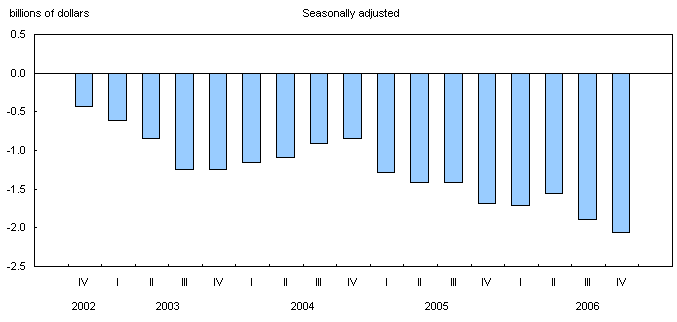 Spending by foreign travellers in Canada increased slightly despite another drop in the number of American same-day travellers. For the year, the $17.1 billion deficit for services was the highest ever. The $3.4 billion increase in the deficit was largely due to higher transportation fares and other trip expenses for Canadians travelling abroad. Both travel and transportation deficits for the year were the highest ever recorded. Takeovers keep foreign direct investment in Canada high Foreign direct investors injected $25.4 billion into the Canadian economy during the fourth quarter, after investments totalling $27.0 billion in the previous quarter. As was the case in the third quarter, most of the fourth quarter investment resulted from foreign acquisitions of Canadian companies. Foreign direct investment in Canada amounted to $75.6 billion in 2006, the second highest on record, and was largely dominated by acquisitions. 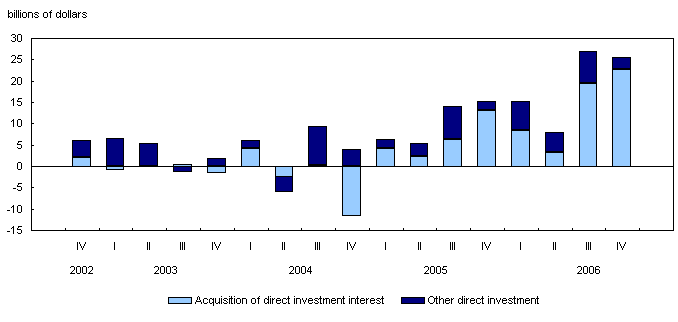 The energy and metallic mineral sector received the bulk of the direct investment from abroad with $13.0 billion, following an investment of $21.5 billion in the third quarter. A record $44.3 billion was invested in this sector of the Canadian economy in 2006. The United Kingdom and the United States were the main direct investors in Canada in 2006, with investments of $22.2 billion and $20.9 billion respectively. Direct investment abroad remains strong Canadian direct investors continued to invest into foreign economies in the fourth quarter. They invested $11.2 billion, on par with the quarterly average investment observed since 2005. The investment of the fourth quarter resulted mainly from injections of working capital into existing affiliates and reinvested earnings.  On an industry basis, the finance and insurance sector dominated all the industries with investments totalling $8.4 billion in the fourth quarter. A slight divestment was observed in the energy and metallic minerals sector. Canadian direct investment abroad was mainly directed to the United States. Over the year, $47.8 billion was invested abroad with a nominal $3.8 billion made through acquisitions. A hefty proportion of the direct investment into foreign economies in 2006 went to the finance and insurance sector ($37.6 billion). Acquisitions of Maple bonds drive the growth in foreign securities Canadians bought $17.6 billion worth of foreign securities over the fourth quarter, with two-thirds in foreign debt instruments. Purchases of foreign securities have been exceeding the $10 billion mark for seven straight quarters. Acquisitions of foreign bonds again surpassed those in foreign equities, a trend started in 2004. Canadians have added an unprecedented $78.3 billion of foreign securities to their portfolios in 2006, with a record $43.0 billion in foreign bonds. 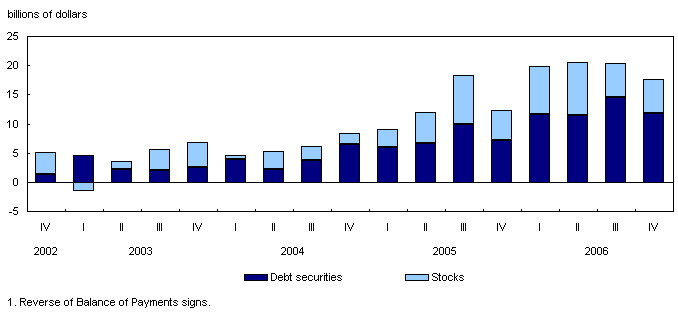 Acquisitions of Maple bonds dominated the investment in foreign bonds, accounting for four-fifths of the $10.3 billion total. Over the year, Canadians have acquired $43.0 billion worth of foreign bonds, with just over 60% accounted for by Maple bonds. Investment in foreign money market paper contributed to the growth in the fourth quarter. Canadians invested $1.5 billion, almost exclusively in overseas paper denominated in Canadian dollars. Acquisitions of US corporate paper were offset by dispositions of US government paper. Canadians were again active in buying foreign shares in the fourth quarter. Of the $5.8 billion acquired, $3.3 billion were US stocks and the remainder was invested in overseas shares. For the entire year, Canadian investors bought $28.9 billion worth of foreign stocks, with two-thirds going to American equities. This was the largest annual investment in the last five years. New issues of Canadian bonds rebound Non-residents invested $3.8 billion in Canadian securities over the fourth quarter, all in Canadian bonds, as they sold off Canadian equities and Canadian money market paper. Foreign investors acquired $10.2 billion worth of Canadian bonds in the fourth quarter, the highest quarterly acquisition in five years. For the year, non-residents invested $28.2 billion in Canadian securities. Investment over the first two quarters was focused on Canadian equities and money market instruments, while investment in the last two quarters was largely in Canadian bonds. 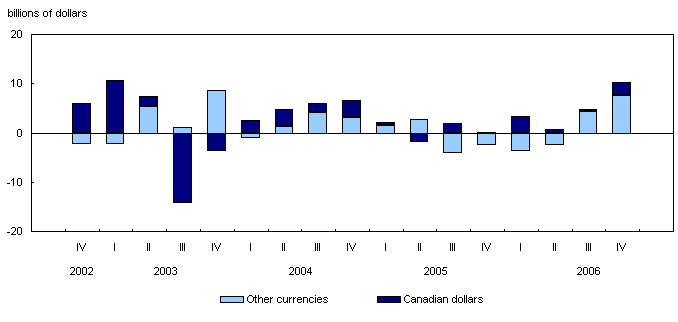 There was a robust $17.6 billion worth of new issues of Canadian bonds placed in foreign markets in the fourth quarter. Most of the new issues in the fourth quarter were initiated by corporations and provincial governments. Retirements were higher as well, resulting in $4.5 billion of net new issues for the quarter. Trading activity with non-residents was up and resulted in non-residents buying $6.1 billion worth of bonds. After acquiring $17.1 billion worth of Canadian equities between January and June 2006, non-residents sold off $5.7 billion in the second half, $4.7 billion of which was in the fourth quarter. The divestment of the fourth quarter was mainly explained by an important foreign acquisition of a Canadian firm, resulting in the withdrawal of foreign-held portfolio shares from the market. Transactions in the other investment account The other investment account recorded a net inflow of $3.2 billion. Large movements of capital occurred in Canada's deposits abroad and deposits of non-residents in Canada. Deposit liabilities were reduced by $18.0 billion in the fourth quarter while on the asset side, the divestment on foreign deposits reached $27.6 billion. Canada's official international reserves decreased slightly while the Canadian dollar depreciated against all its major counterparts. The Canadian dollar closed at 85.8 US cents, down 3.7 US cents from the third quarter. |
|
|
|